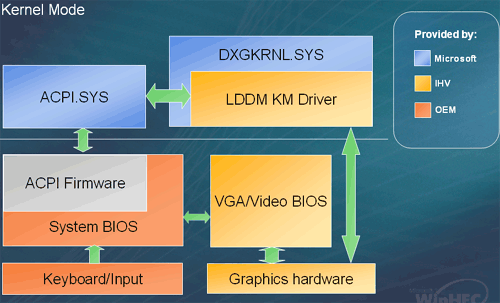WinHEC 2005 - Keynote and Day 1
by Derek Wilson & Jarred Walton on April 26, 2005 4:00 AM EST- Posted in
- Trade Shows
Thoughts on the Longhorn Driver Model
The x64 launch aside, we have heard about some very interesting hardware refinements that Microsoft wants to see happen by the time we reach Longhorn availability. As Gates mentioned in his keynote, the Longhorn driver model is finished. This means that hardware vendors can begin making sure their hardware will run smoothly under Longhorn today. It also means that we are able to catch a glimpse of what things will be like when Longhorn finally comes along.
One of the most interesting things to us is the Longhorn Display Driver Model (LDDM). Under the new display driver model, Microsoft wants to more closely integrate the graphics hardware with the operating system. In order to do this, a couple things are going to happen. First, graphics drivers will give up management of graphics memory to Windows. Windows will then handle the complete virtualization and management needs of graphics memory. This will have a large impact on the way graphics hardware vendors approach driver writing. In spite of the simplification windows memory management will bring to the graphics subsystem, different management techniques may lend themselves more readily to one hardware architecture or another. Right now, we are hearing that ATI and NVIDIA are both playing nice with Microsoft over what will happen when they lose the full control of their own RAM, but we will be sure to keep abreast of the situation.
In addition to the above issues with the LDDM (i.e. Windows sometimes has problems managing system RAM, and now they're going to manage VRAM?), Windows can't manage memory that is taken up by the video bios. There has been a push towards UEFI (Unified Extensible Firmware Interface) as a replacement to the archaic BIOS, and Microsoft would like to see the video BIOS become more entwined with the operating system. The plan right now is to make use of ACPI in order to facilitate this, but we may see even more advancements when we have UEFI hardware. Maintaining a higher level of integration on all fronts with the OS should help make more display options automatic and highly accessible.
Even if UEFI makes it into all hardware platforms by the end of 2006 and graphics hardware vendors take up the cause, we will still need to have legacy BIOS and VGA firmware support in all computers in order to run older (i.e. non-Longhorn) Operating Systems. AMD likens this transition to the current x86-64 transition. Hardware will support legacy and advanced functionality for some time until the user install base is such that legacy support can be dropped.










36 Comments
View All Comments
AtaStrumf - Tuesday, April 26, 2005 - link
OK fitten, that clears up the grammatical "errors", but what's up with the 16-bit colors? Some sort of a graphical pun?mikecel79 - Tuesday, April 26, 2005 - link
There's a typo on page 4 in the 6th paragraph. It reads "The next example given was of SQL Server 2003". It should be "The next example given was of SQL Server 2005".There is no SQL 2003.
ukDave - Tuesday, April 26, 2005 - link
Typo: Page 7, "Thoughts on the Longhorn Driver Model". Second paragraph, last line.'loose' should be 'lose'.
*cough* bored :P
fishbits - Tuesday, April 26, 2005 - link
#10 I always wondered how many more people would try Linux, but were scared off by the hatred and snobbery of so many of its users.Seriously, would you personally be happier if more people moved to Linux, or would you rather they stay where they are so you can feel better hurling abuse at them?
Truder - Tuesday, April 26, 2005 - link
I've seen this news about hybrid harddrives a few places, but I keep wondering about the nand flash on these drives.Wont it wear out relatively quick, due to the numerous rewrites, like other solid state media?
Googer - Tuesday, April 26, 2005 - link
I wish MS would keep their nose out of hardware design. If they start messing up hardware like they do software, then I am permanently becoming a MAC user.Beenthere - Tuesday, April 26, 2005 - link
Why would ANYONE desire to be at WinHell ??? Sombody must be into "PAIN"! From the reviews of Windoze 64 it would appear that MICROSUCKS is the best advertisement in the World for Linux.Viditor - Tuesday, April 26, 2005 - link
"uh, "readily available" "Don't bother me with details...;-)
fitten - Tuesday, April 26, 2005 - link
Just a follow-on:From the site: http://webster.commnet.edu/grammar/determiners/det...
"Merriam-Webster's Dictionary says that we can use an before an h- word that begins with an unstressed syllable. Thus, we might say an hisTORical moment, but we would say a HIStory book. Many writers would call that an affectation and prefer that we say a historical, but apparently, this choice is a matter of personal taste."
fitten - Tuesday, April 26, 2005 - link
#2"An Historical" is grammatically correct British. American English uses "A Historical". I believe either are OK no matter where you are. Do a Google search on "grammar "an historical"" (must have the "an historical" in quotes or google will throw out the "an").
The term "Compute Cluster" has been in use for a decade in the HPC field. Compute clusters are clusters dedicated for computationally intensive tasks (rather than a render farm or a cluster for visualization, for example).